It looks like you're using an Ad Blocker.
Please white-list or disable AboveTopSecret.com in your ad-blocking tool.
Thank you.
Some features of ATS will be disabled while you continue to use an ad-blocker.
share:
Originally posted by AgentSmith
There are people like you who are more questioning and intelligent, but you are so rude, obnoxious and unpleasant I'd rather not be associated with you. There's only room for one rude, obnoxious, unpleasant person in my gang. Me.
Got it.
You are a self-righteous hypocrite.
Now that's out of the way let's leave the sniping and bickering and get back to discussing
Jak
- 9/11: A Boeing 757 *DID NOT* Strike the Pentagon
Jak
Yes thanks.
I feel that one of the biggest indicators that it wasn't a 757 is the lack of any damage whatsoever from the tail section. The tail section is 45 feet tall but add another 5 feet for the engines to hang below the fuselage and 10 feet for the plane to hit the trailer and we should see at least some sort of damage going 60 feet high!
This pic shows that damage tops out at 26 feet!

Nothing close to a tail section was found anywhere. Are we really supposed to believe it disintegrated without impacting the building?
These composite photos demonstrate the sheer size of a 757 with fire trucks, regular trucks, and people as really good reference frames.
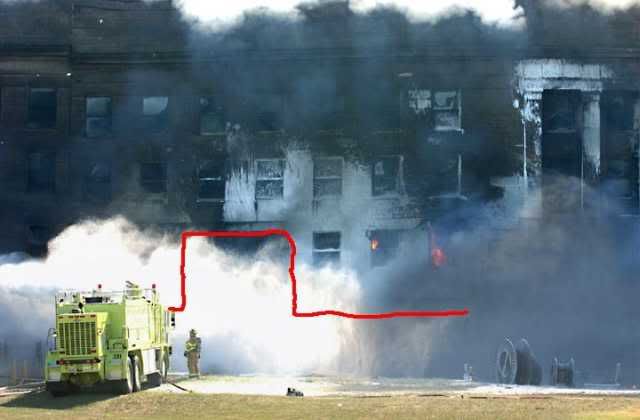
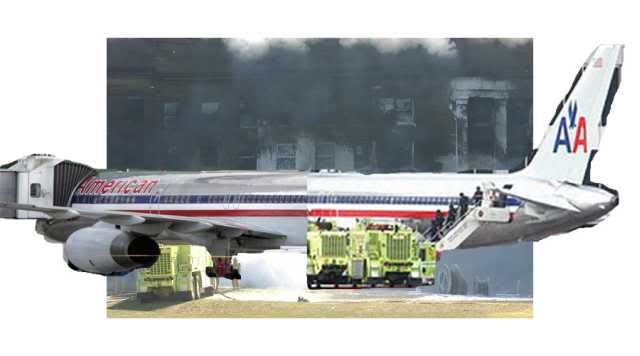
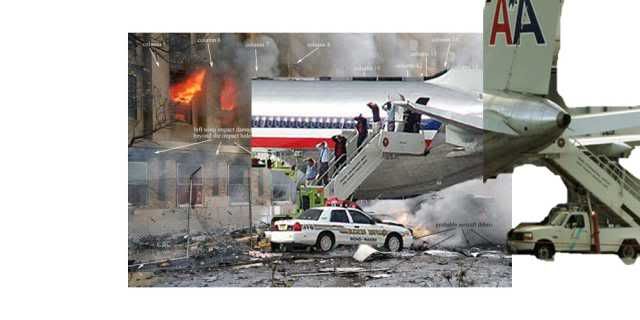
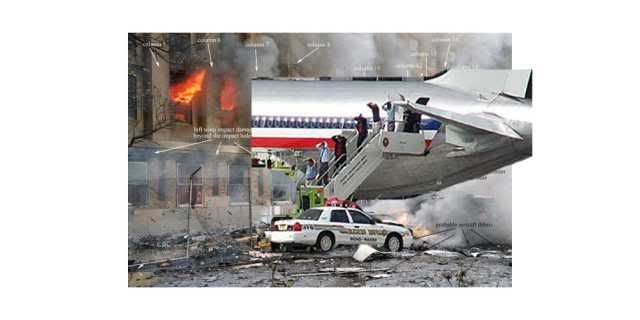
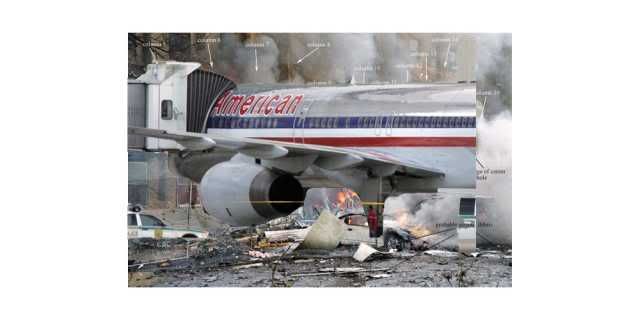
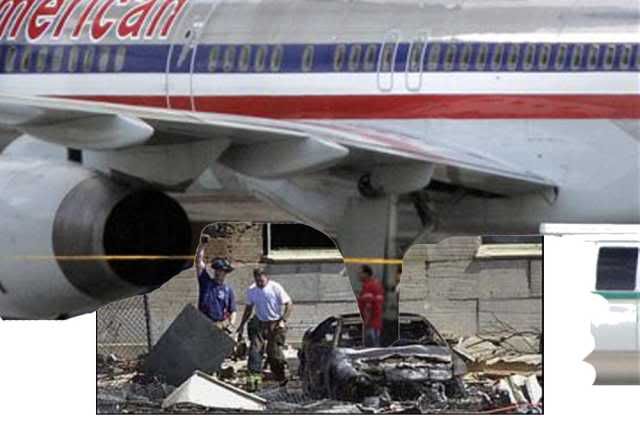
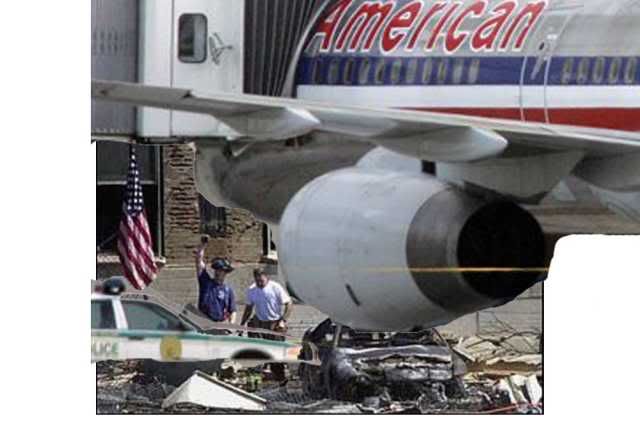
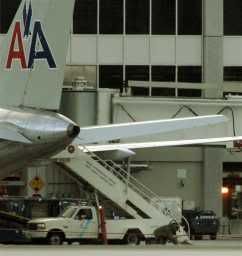
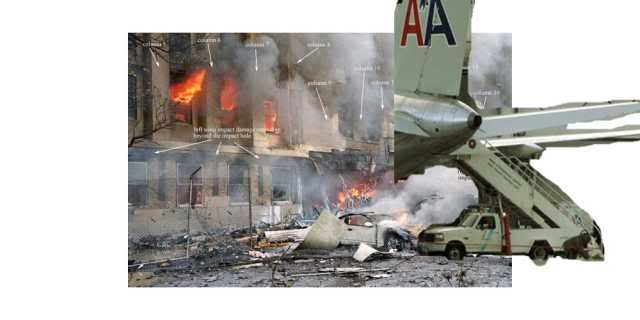

I feel that one of the biggest indicators that it wasn't a 757 is the lack of any damage whatsoever from the tail section. The tail section is 45 feet tall but add another 5 feet for the engines to hang below the fuselage and 10 feet for the plane to hit the trailer and we should see at least some sort of damage going 60 feet high!
This pic shows that damage tops out at 26 feet!

Nothing close to a tail section was found anywhere. Are we really supposed to believe it disintegrated without impacting the building?
These composite photos demonstrate the sheer size of a 757 with fire trucks, regular trucks, and people as really good reference frames.










Originally posted by Jack Tripper
Don't want to look like your trying to deceive anyone there, here's a copy with the aircraft positioned correctly.
Here's the picture of the people with the appropiate scale:
Looking at your own estimation of the width of the main hole, that makes the hole approx 15' 6" wide.
The size of the aircraft:
Basic Dimensions
Wing span 124 ft 10 in (38.05 m)
Overall Length 155 ft 3 in (47.32 m)
Tail Height 44 ft 6 in (13.6 m)
Interior Cabin Width 11 ft 7 in (3.5 m)
Body Exterior Width 12 ft 4 in (3.7 m)
www.boeing.com...
Just for the informational value, no need to attack!
[edit on 17-3-2006 by AgentSmith]
Not trying to deceive anyone.
In fact the plane in my image is actually LOWER than it should have been if you take into account the fact that it cleared this trailer....
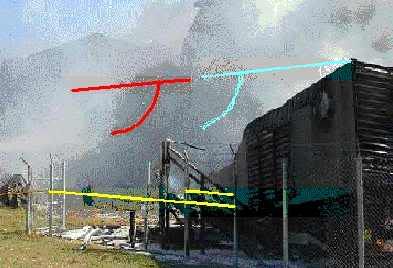
There is no way it could have cleared that trailer AND be as low as you depicted.
And ummmmm thanks for the "information" but nobody has asserted the the hole wasn't wide enough for the fuselage.
Unfortunately for the official story 757's consist of more than a fuselage.
What is your explanation for the tail section?
In fact the plane in my image is actually LOWER than it should have been if you take into account the fact that it cleared this trailer....

There is no way it could have cleared that trailer AND be as low as you depicted.
And ummmmm thanks for the "information" but nobody has asserted the the hole wasn't wide enough for the fuselage.
Unfortunately for the official story 757's consist of more than a fuselage.
What is your explanation for the tail section?
The aircraft banked to the left, meaning the right wing will have been raised. That is in witness reports and actually does agree with the official
story.
The tail section may have disintegrated, also bearing in mind the angle of the tail fin it will have been inclined to tilt back. The wings of aircraft are remarkably fragile in a lot of respects. You also have to ask the same question even if it was a Global Hawk as some claim for instance.
EDIT:
And regarding the trailer, you also have to implement your alternative do not forget, so please do entertain us with your theories regarding that aspect.
[edit on 17-3-2006 by AgentSmith]
The tail section may have disintegrated, also bearing in mind the angle of the tail fin it will have been inclined to tilt back. The wings of aircraft are remarkably fragile in a lot of respects. You also have to ask the same question even if it was a Global Hawk as some claim for instance.
EDIT:
And regarding the trailer, you also have to implement your alternative do not forget, so please do entertain us with your theories regarding that aspect.
[edit on 17-3-2006 by AgentSmith]
No we would not because a global hawk has a MUCH smaller tail fin that would have "disintegrated" even easier or would have been unrecongizable if
it flew over the roof as their video depicts....
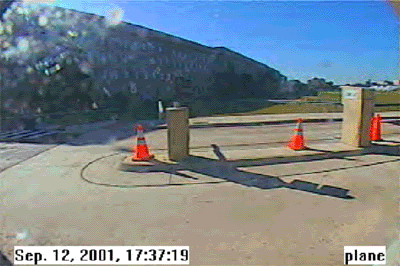
Although I am not asserting it was a global hawk....I am only asserting that it wasn't a 757.
And if the plane was tilted then it STILL couldn't have been as low to the ground as you depicted because the low side would have been digging in the ground!

Although I am not asserting it was a global hawk....I am only asserting that it wasn't a 757.
And if the plane was tilted then it STILL couldn't have been as low to the ground as you depicted because the low side would have been digging in the ground!
Originally posted by AgentSmith
And regarding the trailer, you also have to implement your alternative do not forget, so please do entertain us with your theories regarding that aspect.
No I don't.
I have no definitive alternative theories.
I just know that they are lying.
Where are you getting your stats for the 757s from? Thin air? The engines are NOT 6 tons each, the tail section is NOT 60 feet tall, and even if it
WAS 60 feet that would be FROM THE GROUND looking up to the top of it. NOT from the fuselage.
Jack Tripper wrote:"The tail section is 45 feet tall but add another 5 feet for the engines to hang below the fuselage and 10 feet for the plane to hit the trailer and we should see at least some sort of damage going 60 feet high!"
That means 60 feet off the ground.
The damage is only 26 feet off the ground.
Why are you bringing up the engine weight? We have not discussed that at all recently.
Too bad the tail is only 44 feet 6 inches tall. So again, WHERE are you getting your information? Throwing darts at random numbers on the wall? Not
to mention that if you've ever looked at a tail there's no way in hell that it would punch a hole in almost ANYTHING. There are exactly *TWO* large
bolts that hold a tail attached to the airframe. You're telling me that two bolts are going to be able to withstand hitting a reinforced kevlar wall
at 500 mph, and that thin little tail is going to punch a hole in the wall?
READ dude READ!
"The tail section is 45 feet tall but add another 5 feet for the engines to hang below the fuselage and 10 feet for the plane to hit the trailer and we should see at least some sort of damage going 60 feet high!"
Even if the tail was only connected with a "couple of bolts" if it impacted the building it would have at least left a mark or broke a window don't you think?
And even if it managed to NOT do this.....it would surely have dislodged itslef and landed somewhere. But nope....nowhere to be found.
So you can only maintain that it completely disintegrated without leaving so much as a mark on the building.
Please.
Tail sections survive plane crashes even when the rest of the plane doesn't.
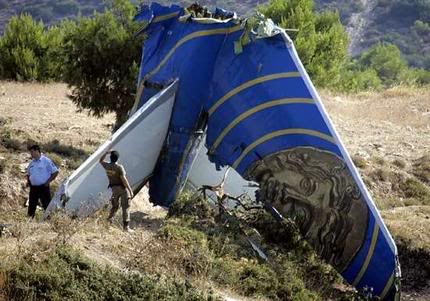
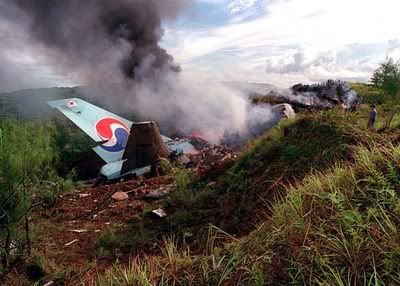
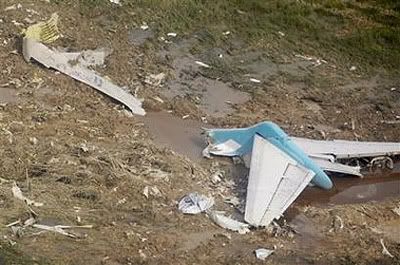
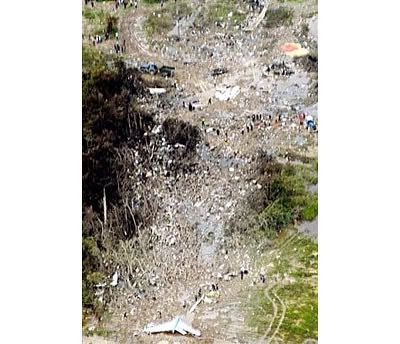
A couple of bolts!
"The tail section is 45 feet tall but add another 5 feet for the engines to hang below the fuselage and 10 feet for the plane to hit the trailer and we should see at least some sort of damage going 60 feet high!"
Even if the tail was only connected with a "couple of bolts" if it impacted the building it would have at least left a mark or broke a window don't you think?
And even if it managed to NOT do this.....it would surely have dislodged itslef and landed somewhere. But nope....nowhere to be found.
So you can only maintain that it completely disintegrated without leaving so much as a mark on the building.
Please.
Tail sections survive plane crashes even when the rest of the plane doesn't.




A couple of bolts!
I have SEEN, and worked on planes where we had to fold the tail over. There are TWO 1 inch bolts holding them in place. Once I have access to my
computer again, I will post pictures of a tail that seperated from the plane, and you can see for yourself how many bolt holes there are to hold that
tail on. The tail SECTION survives, but if you have an impact such as the Pentagon, that thin little tail is NOT going to survive and remain attached
to the fuselage. You're confusing the tail, with the tail SECTION in those pictures.
And considering those windows were designed to withstand a truck bomb touching the wall of the building, No, I wouldn't expect to see shattered windows from the tail.
[edit on 3/17/2006 by Zaphod58]
And considering those windows were designed to withstand a truck bomb touching the wall of the building, No, I wouldn't expect to see shattered windows from the tail.
[edit on 3/17/2006 by Zaphod58]
So is it specifically a 757 tail section that you have seen and worked on?
And sorry but being "blast proof" does not mean "kinetic energy of a 90 ton aircraft traveling at 400 mph proof".
Plus again.............the more you depict the tail as coming off easy (and I don't even deny this) the more I would expect to see it or pieces of it on the front lawn.
You must maintain that it completely disintegrated without even leaving so much as a mark on the building.
And sorry but being "blast proof" does not mean "kinetic energy of a 90 ton aircraft traveling at 400 mph proof".
Plus again.............the more you depict the tail as coming off easy (and I don't even deny this) the more I would expect to see it or pieces of it on the front lawn.
You must maintain that it completely disintegrated without even leaving so much as a mark on the building.
ALL tail sections are held on by two bolts. They have to keep the weight down, especially in the aft fuselage. The more weight you have there the
more it throws the center of gravity off.
You're not TALKING ABOUT the entire 757 hitting the windows, you're talking about the TAIL hitting the windows. If the entire plane had hit those windows then *YES* I would expect them to shatter.
So, you're telling me that the thin little tail is going to hit the wall at 500+ mph, rip off the plane, and lay there perfectly intact on the front lawn?
You're not TALKING ABOUT the entire 757 hitting the windows, you're talking about the TAIL hitting the windows. If the entire plane had hit those windows then *YES* I would expect them to shatter.
So, you're telling me that the thin little tail is going to hit the wall at 500+ mph, rip off the plane, and lay there perfectly intact on the front lawn?
"Thin and little"??
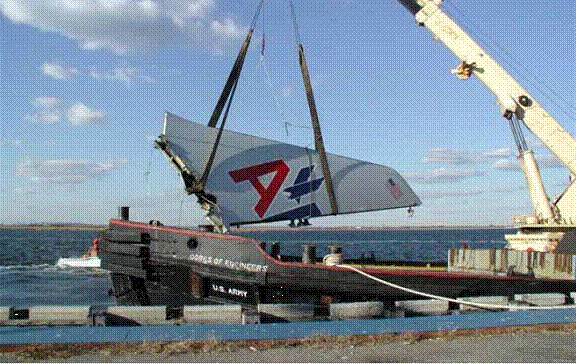
Hardly.
As you have already implied with your "two bolts" statement........it is actually designed to come unattached when overstressed....
This image shows where one of your "bolts" separated from the plane in the accident referenced above...

So since it's actually designed to dislodge from the plane and we see ZERO damage from where it would have impacted it seems like it is safe to assume it would have performed as it was designed and as has been demonstrated in so many other plane crashes...............it would have came loose and ended up in front of the pentagon.
Does that mean it would have been "perfectly intact"? Ummmm not necessarily and I didn't claim this. Although it is quite likely.
But it certainly does mean that we should expect to at least see some pieces of this SUPER BIG AND HEAVY 45 FOOT TALL vertical stabilizer made with toughened graphite that was designed to detach in front of the pentagon!
(toughened graphite became standard in commercial aircraft since the widespread use of composites in 1987.....source)
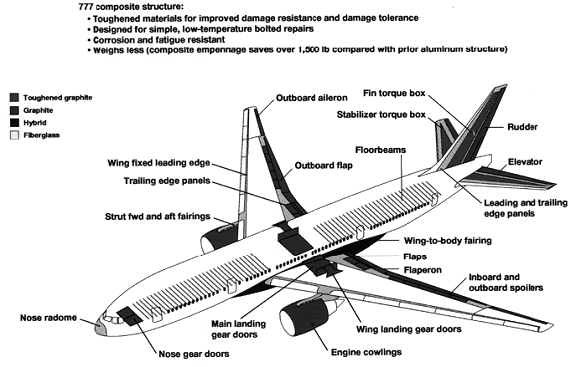
Looks like they sure didn't skimp on the tail!

Hardly.
As you have already implied with your "two bolts" statement........it is actually designed to come unattached when overstressed....
Flight 587’s vertical stabilizer performed in a manner that was consistent with its design and certification. The vertical stabilizer fractured from the fuselage in overstress, starting with the right rear lug while the vertical stabilizer was exposed to aerodynamic loads that were about twice the certified limit load design envelope and were more than the certified ultimate load design envelope.
www.ntsb.gov...
This image shows where one of your "bolts" separated from the plane in the accident referenced above...

So since it's actually designed to dislodge from the plane and we see ZERO damage from where it would have impacted it seems like it is safe to assume it would have performed as it was designed and as has been demonstrated in so many other plane crashes...............it would have came loose and ended up in front of the pentagon.
Does that mean it would have been "perfectly intact"? Ummmm not necessarily and I didn't claim this. Although it is quite likely.
But it certainly does mean that we should expect to at least see some pieces of this SUPER BIG AND HEAVY 45 FOOT TALL vertical stabilizer made with toughened graphite that was designed to detach in front of the pentagon!
(toughened graphite became standard in commercial aircraft since the widespread use of composites in 1987.....source)

Looks like they sure didn't skimp on the tail!
Now you're comparing a 777 to a 757? That's a good one. The use of composites became standard in 1987. 1987. Too bad the 757 was built in
1983. They don't change materials in midproduction without a VERY good reason, because then they have confusion in maintenance as to which
plane has material a and which material b, and you have to have twice as many maintenance people. Some trained in composites, some trained in
aluminum. The 777 was the *FIRST* plane built by Boeing that used composites in any significant amount.
Fine then smarty pants.........what was it made of?
Is it unreasonable to consider the chart above somewhat proportionate as to the relative strength of the various materials within a 757?
Is it unreasonable to consider the chart above somewhat proportionate as to the relative strength of the various materials within a 757?
Considering that the 757 was mostly aviation grade aluminum, with some titanium and steel, and the 777 was 10% composites, with aviation grade
aluminum, titanium and steel, YES it is unreasonable. It's like saying that steel, and plastic have similar strengths. Aviation grade aluminum and
reinforced graphite have VASTLY different strengths.
What I am suggesting is that within the reference frame of a 757; the tail is made of some of the stronger materials in general as depicted.
new topics
-
V.P. Kamala Harris releases a video and nobody understands why
US Political Madness: 7 minutes ago -
D.B. Cooper mystery may be solved
General Conspiracies: 4 hours ago
top topics
-
D.B. Cooper mystery may be solved
General Conspiracies: 4 hours ago, 14 flags -
V.P. Kamala Harris releases a video and nobody understands why
US Political Madness: 7 minutes ago, 1 flags
active topics
-
V.P. Kamala Harris releases a video and nobody understands why
US Political Madness • 1 • : Flyingclaydisk -
Results of the use of the Oreshnik missile system in Dnepropetrovsk
World War Three • 243 • : Oldcarpy2 -
D.B. Cooper mystery may be solved
General Conspiracies • 20 • : Flyingclaydisk -
I thought Trump was the existential threat?
World War Three • 82 • : Xtrozero -
Interesting Video-UFO?
Aliens and UFOs • 17 • : Flyingclaydisk -
Well, here we go red lines crossed Biden gives the go ahead to use long range missiles
World War Three • 398 • : andy06shake -
How Long have You been Alive?
General Chit Chat • 34 • : Flyingclaydisk -
Mood Music Part VI
Music • 3717 • : BrucellaOrchitis -
Federal law trumps state and local law every time
Social Issues and Civil Unrest • 31 • : fringeofthefringe -
Petition Calling for General Election at 564,016 and rising Fast
Political Issues • 97 • : BrucellaOrchitis
